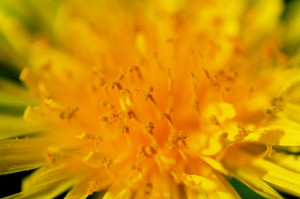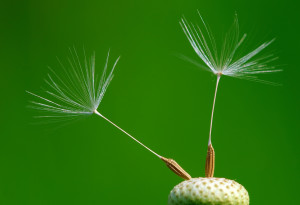Why Dandelions?
 Whether you love them or whether you hate them, dandelions are perhaps the most familiar plant in the world. They’re the one species of plant that just about anyone can identify at a glance, familiar to humans as the dog.
Whether you love them or whether you hate them, dandelions are perhaps the most familiar plant in the world. They’re the one species of plant that just about anyone can identify at a glance, familiar to humans as the dog.
This most common of plants is now a despised weed, but it wasn’t always that way. Dandelions were once a valued commodity, purposely transported by humans across oceans and continents. Americans today spend forty billion dollars annually on lawn care, and a hefty part of that budget goes to the attempt to eradicate dandelions–the very plant that was brought to this country by its earliest settlers, who prized the plant for its medicinal powers, and nurtured the cheerful golden flowers for their beauty. Not too long ago, prize dandelions were exhibited at county fairs–one variety was patriotically christened the “American Improved.” Gardeners used to weed out the grass to make room for the dandelions.
What happened? In an amazingly short space of time–less than one human life-span–this loved garden flower became the most unpopular plant in the neighborhood. Thirty million acres of the United States are lawns, and an estimated eighty million pounds of pesticides are used on them annually. Probably no other plant in the world undergoes such a barrage of deadly chemicals; humans have attempted to exterminate dandelions with a passion that’s usually reserved for cockroaches or tarantulas. Yet the dandelion remains.
How does the dandelion do it? What’s the secret of its success? In these days of environmental destruction, thousands of species are on the verge of extinction. Not just California condors and blue whales, plants are in peril, too; wild orchids and ferns, painted trillium and pink lady-slippers: whole species are declining in spite of frantic efforts to preserve them. An estimated 100,000 species of plants are in danger of extinction worldwide. It might be worth our while to examine how it happens that the dandelion can thrive, in the most inhospitable of habitats, defying humans’ best efforts to get rid of it.
Reviews
“An enchanting and fascinating read, highly recommended for plant lovers of all walks of life.”
— Excerpt from The Midwest Book Review, Small Press Bookwatch, March 2007
“…The flower has a champion. Anita Sanchez…. The book explores the history of the flower–once revered and valued for its medicinal qualities–and how it became the much maligned ‘weed’ that homeowners douse with pesticides to banish from lawns…. The book is a swift-moving and elegantly written ode to the dandelion, steeped in botanical and environmental history. It’s also prescient to this era of new eco-consciousness and sustainability without being overbearing or sanctimonious. Plus, it’s a really nice read for a summer day.”
— Excerpt from Times Union, Albany, NY, Donna Liquori, freelance writer, July 1, 2007
“Whether one hates dandelions with a passion, can tolerate them, or even eat them, this book is a fascinating insight into the world of the dandelion. …Being a native Pennsylvanian, I was surprised to learn that one of the sayings of the Pennsylvania Dutch was that, ‘if you eat dandelion on Maundy Thursday (early Spring) you’ll be healthy all year.’ Little did they know that behind this saying is the fact that, ‘dandelions are a vitamin powerhouse.’ Sanchez backs this with surprising factual information…–this humble plant offers a wealth of gifts. ”
— Shirley Dumbold, Federated Garden Clubs of New York State newsletter, The News, Winter 2006-2007, Vol. 78, No. 3
“Sanchez…is much more than a historian. She writes beautifully, on a topic that most of us would not have thought worth pursuing until we discovered this book. It is difficult to write of The Teeth of the Lion without quoting from it.”
— Tony P. Wrenn, excerpt from “In a Virginia Garden,” The Free Lance-Star, Fredericksburg, VA
The Amazing Dandelion
-
Dandelions were well known to ancient Egyptians, Arabs, Greeks, and Romans, and have been used in Chinese traditional medicine for over a thousand years.
- Dandelions have a well-documented ability to help the liver, the body’s filter, remove toxins from the bloodstream. They serve as gentle diuretic that provides nutrients and helps the digestive system function at peak efficiency.
- Springtime Dandelion Festivals flourish nation-wide, where you can enjoy traditional delicacies like dandelion sausage, dandelion ice cream or dandelion gravy–and of course, dandelion wine.
- The morning after sampling dandelion wine, try dandelion tea: dandelions help the liver flush hangover-inducing toxins from the system and are the perfect remedy to get rid of the deadly “hangover headache.”
- Dandelions have been used in witchcraft for millennia: their milky sap recalled mother’s milk, and indicated that they were potent ingredients for fertility charms.
- Dandelion greens are one of the most nutritious plants in the garden, full of vitamins and minerals. The sweetest greens are gathered before the plant flowers. But don’t collect them near roadways, or from lawns treated with pesticides
- Dandelions hate shade! There’s a green way to have a dandelion-free lawn: let the grass grow 3 or 4 inches tall to shade out the sun-loving dandelions.
- Dandelions hate acid soil! A dollop of vinegar can get rid of pesky dandelion in cement cracks and lawn edges.
- Dandelions are one of the few plants that can clone their own seed, a rare botanical ability called “apomixis.” Dandelions do not require insect pollination, and the recent collapse of numerous honeybee hives won’t have a marked effect on dandelion populations.
From the Book:
It’s the very definition of springtime: the cheerful sight of a robin pulling a worm out of the new green grass. But the robin who goes worm-hunting on a well-tended lawn may be bringing more than a tasty meal home to his youngsters. If the neatly-trimmed, dandelion-free lawn has been treated with a pesticide, the robin and his family may become statistics. It’s estimated that more than seven million wild birds are killed by the aesthetic use of lawn pesticides in the United States, every year. (1) Aesthetic use: that doesn’t mean agricultural pesticides to grow food crops. That means the use of pesticides to make our lawns and gardens look nice.
 Seven million wild birds, dead. To get rid of, among other things, dandelions.
Seven million wild birds, dead. To get rid of, among other things, dandelions.
Rachel Carson’s classic book Silent Spring woke the world to the dangers of pesticides. I have a copy of it, an old 1964 paperback I bought for a quarter at a garage sale. “The explosive best-seller that is shocking the world!” screams the advertising on the cover. But I rarely encounter anyone, these days, who has actually read the book. No wonder, really–Silent Spring may have been an “explosive best-seller,” but it’s not exactly a thriller. It’s long and dull, full of depressing details and statistics, very tough going. Knowing that the pesticide industries would oppose her findings bitterly, Rachel Carson spent years in painstaking research, in order to be sure that the facts her book contained would be incontrovertible, and her grim findings don’t make for light reading.
…
Unlike Silent Spring, the label of a container of chemical pesticide–any brand–is certainly not dull reading. All sorts of words usually found in murder mysteries and spy novels leap out at you. “Fatal…poison…danger…death…” Anyone, of any age, can buy pesticides off the shelf and use them at home without any sort of license, and therefore we tend to assume that lawn and garden pesticides are trivial, everyday stuff, as harmless as, say, dish detergent–just to clean up your lawn a trifle.
What if a bird-lover puts up a feeder on a lawn that has been treated with herbicide for dandelions? People enjoy seeing sparrows and chickadees hopping around on the grass, pecking at seeds. But they don’t see what happens after the birds fly away. Our knowledge of pesticides’ effects on birds is like a pyramid-shaped iceberg, in which the widest portion by far remains unseen. Only a few dead birds are noticed and collected, but it’s probable that the vast majority of bird deaths caused by pesticides go undetected.
Pesticides are poisons. They kill living things. On every package there is the number of a poison control center, or instructions to physicians. Obviously, if you drink the pesticide, it’s a threat to your health. But even if you follow the directions and apply the pesticide precisely as instructed by the manufacturer, pesticides kill things. Dandelions, but also robins. Weeds, but also butterflies, cardinals, song sparrows, chickadees, dogs, cats, ladybugs, bluebirds, meadowlarks…
And children? Children have long been identified as being especially vulnerable to pesticide exposure. Their developing bodies are at greater risk from toxins. Also, they don’t sit in chairs on the deck, sip iced tea, and merely gaze at the lawn. Children play on lawns: they roll down the hill, lie on the grass, chew grass blades, blow dandelion puffballs. Like the robins and the neighborhood dogs and cats, they can’t read the little signs with the tiny letters warning that this lawn has been treated with herbicides.
Rachel Carson waded though enormous piles of reports and scientific documents as she quoted the horrifying statistics of wildlife and human deaths caused by pesticides. A true scientist, she wrote for the most part in a clinical, almost detached style as she reported the details of bird kills. But sometimes her anger broke through, and one can feel her passion: “Who has made the decision that sets in motion these chains of poisonings, this ever-widening wave of death that spreads out, like ripples when a pebble is dropped into a still pond? Who has placed in one pan of the scales…the pitiful heaps of many-hued feathers, the lifeless remains of the birds…”
…
A lawn that has been drenched with pesticide looks like any other lawn, pretty much. Pesticides are more or less invisible: they have no strong smell, there’s little sign of their presence. How can I tell which lawn I can let my child play on? Where can a robin get a worm to bring home to the nestlings? What’s a parent to do?
Seems like there should be some sort of marker, a badge of safety, a brightly-colored seal of approval on the grass of organic lawns. Something easy to spot, scattered across the grass to tell children that this field is safe to play on, this hill is safe to roll down. Some signpost should promise that the worms that a robin pulls out of this lawn won’t bring slow death to baby robins; the dog who plays catch on this grass won’t be at risk for neurological damage; walking barefoot on this lawn won’t bring a higher risk of leukemia to my toddler.
Well, there is such a marker, and it’s bright yellow.
I like to imagine Rachel Carson smiling, as she gazes at the birds on my lawn, and the grass sparkling with dandelions.
Photo credits (used with Creative Commons license. Use does not connote endorsement.):
- Dandelion seeds: Akènes de pissenlit by Luc Viatour on Flickr
- Closeup: Dandelion (closeup) by Jeff Kubina on Flickr






Recent Comments